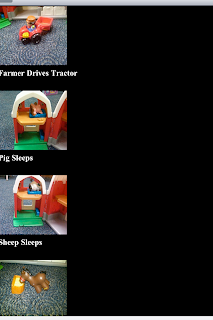I have been working with a little boy for about a year and four months now. He just turned three, and he has a dx of PDD-NOS. He makes progress, but does experience fairly significant regression when he goes away for a week. The first time I noted this was in February. He recouped some of it, but not to the point that he was prior to his vacation. His level of skill remains, though his connectedness and consistency in demonstrating his skills has decreased. He recently went away for a week again and again, he came back demonstrating regression. When I saw him for the first time since he returned from vacation, his teachers informed me that he was now only saying the first part of words. Their example was that he would only say "crack" when requesting a cracker. Prior to vacation, he was speaking in 3-4 word utterances, often rote, but used appropriately and spontaneously. I got a glimpse of this partial word use the moment we began working together that day. We were reading
Dear Zoo. When I paused to allow him to fill in the animal, he said "ele" for elephant...giraffe was "gir" and lion was "li." This persisted throughout the session, despite the different strategies I tried to elicit full production of words (which he was able to do prior to vacation.) I saw him two days later, and this pattern continued to persist. He is motivated by the iPad, however even his favorite apps as reinforcers did not motivate him to use full words. I decided to try an app that I had not previously used with him...Play-n-Say House by Acoco Interactive. The title page for this app has two options, basic play, in which the label of the picture is said, and then then the child can interact with what is on the screen, and advanced play that allows for speech recognition. In this option, the scene does not become interactive until the child repeats the word back. My intent was to use this option, thinking that hearing his own voice and/or the interaction with the screen after saying a word may motivate him to say the whole word. I introduced the app using the basic option. Well, he was just taken with the app from the first screen. He was repeating each word fully, engaging with the screen and using nice joint attention with me. We stayed with this for awhile. When it was time to transition to another activity, I wondered if this would actually generalize, such that he would use full words within our next activity. To my excitement (and a little to my surprise) it did generalize, and he was using full words within 2-3 word utterances for the rest of the session! (Hopefully this will generalize across settings!) This app is free, but well worth it even if it did cost something.





